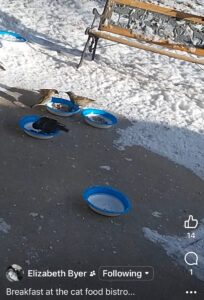Family
 Beating the computer…sound impossible. Well for most of us, it probably is. Garry Kasparov would be the exception to that statement. Still, it was not a common event…even for Kasparov. On February 10, 1996, at the Pennsylvania Convention Center in Philadelphia, Kasparov was beaten by a computer called Deep Blue in the first game of a six-game match, marking the first time a computer had ever beat a human in a formal chess game. Prior to that time, most likely no one had programmed a computer to really play chess. So, it was experimental. Since that time, computers have improved significantly, and today they can easily surpass scores of 3500, while the current all-time human record is 2882. Not being a chess player, I can’t exactly say that that I know about the scoring system.
Beating the computer…sound impossible. Well for most of us, it probably is. Garry Kasparov would be the exception to that statement. Still, it was not a common event…even for Kasparov. On February 10, 1996, at the Pennsylvania Convention Center in Philadelphia, Kasparov was beaten by a computer called Deep Blue in the first game of a six-game match, marking the first time a computer had ever beat a human in a formal chess game. Prior to that time, most likely no one had programmed a computer to really play chess. So, it was experimental. Since that time, computers have improved significantly, and today they can easily surpass scores of 3500, while the current all-time human record is 2882. Not being a chess player, I can’t exactly say that that I know about the scoring system.
Being beaten at chess was not something Kasparov took kindly to. After all, he was a world class player. Nobody was supposed to beat him, much less a machine. He could hardly stand it. It became an obsession. He was determined to beat the computer. Then, on February 17th…the final day of the tournament, Kasparov actually beat Deep Blue. It was the final game of a six-game match, and IBM’s chess-playing computer finally lost. Kasparov won the match, 4-2. While he had his victory, the sweetness of it was short lived, because the  following year, in a widely publicized rematch, Deep Blue once again went on to defeat Kasparov.
following year, in a widely publicized rematch, Deep Blue once again went on to defeat Kasparov.
Kasparov was born April 13, 1963, in the Russian republic of Azerbaijan. In 1985, at 22, Kasparov became the youngest world champion in history when he defeated Anatoly Karpov. The computer, Deep Blue can also be traced back to 1985, when Feng Hsiung Hsu, a Carnegie Mellon University doctoral student, began developing a chess-playing computer called “ChipTest,” which later became known as “Deep Thought,” after a machine in the science-fiction novel The Hitchhiker’s Guide to the Galaxy by Douglas Adams. IBM saw value in Hsu and his collaborators, Murray Campbell, and Thomas Anantharaman, and later hired them, to continue to work on the chess-playing computer. Deep Thought evolved, but in 1989, Gary Kasparov easily trounced it when they met for a 2-game match. Not giving up, the IBM team continued to refine their supercomputer. In 1993, it was renamed “Deep Blue,” a combination of Deep Thought and Big Blue, which was IBM’s nickname.
“Deep Blue” was capable of evaluating 100 million different chess positions per second. Nevertheless, the IBM team wasn’t sure how the computer would perform in competition and Kasparov was favored to win. How odd is  it that a man was favored to win over a computer. Still, it was so. In a frustrating turn of events, Kasparov lost the first game to “Deep Blue.” Not to be outdone, he came back and won the second game. The third and fourth games ended in a draw, and Kasparov won the fifth game. On February 17, the human chess master triumphed over Deep Blue in the sixth game and took the match, with a final score of 4-2. Of course, computers have evolved over the years, and these days it is believed that no human cam beat the computer. I guess time will tell if that is the case. As for Kasparov, well, he retained his world chess champion title until 2000. In March 2005, he announced his retirement from professional chess.
it that a man was favored to win over a computer. Still, it was so. In a frustrating turn of events, Kasparov lost the first game to “Deep Blue.” Not to be outdone, he came back and won the second game. The third and fourth games ended in a draw, and Kasparov won the fifth game. On February 17, the human chess master triumphed over Deep Blue in the sixth game and took the match, with a final score of 4-2. Of course, computers have evolved over the years, and these days it is believed that no human cam beat the computer. I guess time will tell if that is the case. As for Kasparov, well, he retained his world chess champion title until 2000. In March 2005, he announced his retirement from professional chess.
 Potatoes weren’t very popular in France at first. This changed when Antoine-Augustin Parmentier took matters into his own hands to promote the potato as a food source for humans in France. He’d surround his potato patch with guards during the day, to suggest valuable goods were growing there, and then remove the guards at night so people would come and steal the potatoes. You might ask why he would do such a thing. Well, during the Seven Years War, when Parmentier was a prisoner of war, he was given potatoes and discovered their nutritional value. Before Parmentier’s efforts, the French thought that potatoes were poisonous and disgusting. Parmentier’s potato patch was a plot of land near Neuilly, west of Paris. There he grew potatoes to promote their consumption. Parmentier’s efforts were successful in making potatoes a staple of the French diet.
Potatoes weren’t very popular in France at first. This changed when Antoine-Augustin Parmentier took matters into his own hands to promote the potato as a food source for humans in France. He’d surround his potato patch with guards during the day, to suggest valuable goods were growing there, and then remove the guards at night so people would come and steal the potatoes. You might ask why he would do such a thing. Well, during the Seven Years War, when Parmentier was a prisoner of war, he was given potatoes and discovered their nutritional value. Before Parmentier’s efforts, the French thought that potatoes were poisonous and disgusting. Parmentier’s potato patch was a plot of land near Neuilly, west of Paris. There he grew potatoes to promote their consumption. Parmentier’s efforts were successful in making potatoes a staple of the French diet.
While trying to promote potatoes, Parmentier did crazy things, like holding dinners where he served potato dishes. I can only imagine how hard it was to get people to try  his dishes. He also gave bouquets of potato flowers to the king and queen…seriously!! I wonder how the king and queen reacted to that!! Parmentier also surrounded his potato patch with armed guards during the day, and instructed them to let thieves steal the potatoes at night. That way, the people thought the potatoes were some kind of exotic good of great value. He also published a Treatise on the Culture and Use of the Potato, Sweet Potato, and Jerusalem Artichoke in 1789. This man was totally dedicated to the potato.
his dishes. He also gave bouquets of potato flowers to the king and queen…seriously!! I wonder how the king and queen reacted to that!! Parmentier also surrounded his potato patch with armed guards during the day, and instructed them to let thieves steal the potatoes at night. That way, the people thought the potatoes were some kind of exotic good of great value. He also published a Treatise on the Culture and Use of the Potato, Sweet Potato, and Jerusalem Artichoke in 1789. This man was totally dedicated to the potato.
Born on August 12, 1737, Parmentier was a French pharmacist and agronomist, who was best remembered as a vocal promoter of the potato as a food source for humans in France and throughout Europe, but his many other contributions  to nutrition and health included establishing the first mandatory smallpox vaccination campaign in France (under Napoleon beginning in 1805, when he was Inspector-General of the Health Service) and pioneering the extraction of sugar from sugar beets. Parmentier also founded a school of breadmaking and studied methods of conserving food, including refrigeration.
to nutrition and health included establishing the first mandatory smallpox vaccination campaign in France (under Napoleon beginning in 1805, when he was Inspector-General of the Health Service) and pioneering the extraction of sugar from sugar beets. Parmentier also founded a school of breadmaking and studied methods of conserving food, including refrigeration.
Parmentier died on December 13, 1813. He was 76. He is buried in Père Lachaise Cemetery in Paris. His grave is ringed by potato plants. He was also honored with his name given to a long avenue in the 10th and 11th arrondissements (and a station on line 3 of the Paris Métro). His bronze statue was placed at Montdidier and surveys Place Parmentier from its high socle, while below, in full marble relief, seed potatoes are distributed and another monumental statue of Parmentier, by French sculptor Adrien Étienne Gaudez, in the square of the town hall of Neuilly-sur-Seine.

 While I didn’t see her in person very often, my cousin Liz Byer was a bright light shining from Facebook into the lives of those privileged enough to call her friend. She loved flowers, making Spring and Summer her seasons of choice, but she actually received a gift from Jesus on December 27th, when some of her outdoor flowers decided to be “blooming idiots” by blooming in the Winter. Leave it to Liz to come up with that. The reality is that she often came up with funny things. That was a big part of her charm. She would post things like “All of my flabbers are gasted” or show a picture of the birds at her “cat food bistro.” You really had no choice but to laugh at the stuff she found to brighten the day of anyone who followed her page. I would often go look at her page just to start my day with a smile. Oh…how I will miss those silly little posts.
While I didn’t see her in person very often, my cousin Liz Byer was a bright light shining from Facebook into the lives of those privileged enough to call her friend. She loved flowers, making Spring and Summer her seasons of choice, but she actually received a gift from Jesus on December 27th, when some of her outdoor flowers decided to be “blooming idiots” by blooming in the Winter. Leave it to Liz to come up with that. The reality is that she often came up with funny things. That was a big part of her charm. She would post things like “All of my flabbers are gasted” or show a picture of the birds at her “cat food bistro.” You really had no choice but to laugh at the stuff she found to brighten the day of anyone who followed her page. I would often go look at her page just to start my day with a smile. Oh…how I will miss those silly little posts. 

Liz was born with Brittle Bone Disease, but she never let that get her down. She always wore a smile and always had a kind word or a funny quip to lift the spirits of those around her. You may not have even been feeling down, but after you talked to Liz or read her posts, you knew that your day got just a little bit brighter. She had a way of making your day better, even when you didn’t know you needed that. That is a person who is a bright light. That was Liz.
Liz’s top priority, after the Lord, was her family. She was married to my cousin Tim Byer on July 12, 1986. I’m sure that one of the things Tim noticed first about Liz, was her winning smile. You could just see the joy in her heart through her smile. Their marriage brought them two sweet daughters, Danielle Elizabeth and Nickole Marie, and when the girls married, they added James Forseen and Caleb Holscher. Liz and Tim now have six beautiful grandchildren, Natasha Elizabeth, Eleanor Mercedes, Joanna Carlyne, and Henry Axel Forseen; and James Timothy and Judah Everett 
 Holscher. They are her pride and joy. Together, Liz and Tim started a beautiful family, and their family will continue on long into the future. While her home going will bring sadness to the family, they know that because she had accepted Jesus as her Lord and Savior, she is not in their past now, but rather in their future. They will see her again when they all join her in Heaven with the Lord. We will all miss Liz very much. Liz, we love you and look forward to seeing you again when we go to Heaven too.
Holscher. They are her pride and joy. Together, Liz and Tim started a beautiful family, and their family will continue on long into the future. While her home going will bring sadness to the family, they know that because she had accepted Jesus as her Lord and Savior, she is not in their past now, but rather in their future. They will see her again when they all join her in Heaven with the Lord. We will all miss Liz very much. Liz, we love you and look forward to seeing you again when we go to Heaven too.

 Paris is known as the city of love, and France is famous for love, so it’s not too surprising that it is thought that the first-ever Valentine’s Day card originated in France. At that time, Charles, the Duke of Orleans was in prison as a prisoner of war. He spent 25 years there, and he sent love letters to his wife from there in 1415. These days, the French village called “Valentine” turns into the epicenter of romance between the 12th and 14th of February. Everyone gets in on the fun. Yards, trees, and homes, are decorated with love cards, roses, and proposals for marriage. It seems like everyone gets in on the fun, making it one of the most beautiful Valentine’s Day traditions in the world. And it all started from a prison cell. Charles was allowed to live in relative freedom, and could even write letters, but he was not allowed to go free or be ransomed for almost 25 years. Sadly, his wife Bonne of Armagnac, the daughter of Bernard VII, Count of Armagnac, died before he returned from captivity. So, while he was rather famous for his letters and poems to her, they did him no real good. Still, their love was an unending love.
Paris is known as the city of love, and France is famous for love, so it’s not too surprising that it is thought that the first-ever Valentine’s Day card originated in France. At that time, Charles, the Duke of Orleans was in prison as a prisoner of war. He spent 25 years there, and he sent love letters to his wife from there in 1415. These days, the French village called “Valentine” turns into the epicenter of romance between the 12th and 14th of February. Everyone gets in on the fun. Yards, trees, and homes, are decorated with love cards, roses, and proposals for marriage. It seems like everyone gets in on the fun, making it one of the most beautiful Valentine’s Day traditions in the world. And it all started from a prison cell. Charles was allowed to live in relative freedom, and could even write letters, but he was not allowed to go free or be ransomed for almost 25 years. Sadly, his wife Bonne of Armagnac, the daughter of Bernard VII, Count of Armagnac, died before he returned from captivity. So, while he was rather famous for his letters and poems to her, they did him no real good. Still, their love was an unending love.
Sadly, some valentines have good endings and others don’t, but the idea of valentines, and Valentine’s Day is as timeless as the love between Charles and Bonne. Every year, couples exchange things like cards, candy, flowers, and gifts to show their love for one another. Many of these gifts are exchanged over a nice dinner and wine. Other times, the dinners might be held at home, even including the children of the couple. It doesn’t 
 really matter how it is done…the idea is to celebrate the love the couple has for each other. Some people might think the tradition is silly, but usually those are the people who don’t have anyone to spend the day with. Some people think that it has become too commercialized, and maybe it has, but as commercialization goes, this one seems to be the sweetest. Happy Valentine’s Day!! I hope yours is very special.
really matter how it is done…the idea is to celebrate the love the couple has for each other. Some people might think the tradition is silly, but usually those are the people who don’t have anyone to spend the day with. Some people think that it has become too commercialized, and maybe it has, but as commercialization goes, this one seems to be the sweetest. Happy Valentine’s Day!! I hope yours is very special.

 Lawmen are supposed to be the keepers of the law and the protectors of the people, but that is not always the case, in the Old West or even today. One such group was the Dodge City Gang, comprised of a group of notorious Kansas gunfighters and gamblers who dominated the political and economic life of Las Vegas, New Mexico in 1879 and early 1880. Their leader was Hyman G Neill, better known as Hoodoo Brown, had managed to secure the position of justice of the peace in Las Vegas, Nevada. Brown quickly put together a gang of unlikely lawmen, including fighters from the recent Railroad Wars of Raton, New Mexico and Royal Gorge, Colorado. These included John Joshua Webb, “Dirty” Dave Rudabaugh, and Mysterious Dave Mather. Doc Holliday was in town at that time, and he was friendly with gang members, though he is not generally listed as a member of the loose-knit association. At the time, Las Vegas was booming and was thought to be the future metropolis of New Mexico. As with many a boomtown, it attracted a number of opportunists and outlaws, making the need for lawmen very important, and that meant they weren’t always chosen for their lack of criminal record.
Lawmen are supposed to be the keepers of the law and the protectors of the people, but that is not always the case, in the Old West or even today. One such group was the Dodge City Gang, comprised of a group of notorious Kansas gunfighters and gamblers who dominated the political and economic life of Las Vegas, New Mexico in 1879 and early 1880. Their leader was Hyman G Neill, better known as Hoodoo Brown, had managed to secure the position of justice of the peace in Las Vegas, Nevada. Brown quickly put together a gang of unlikely lawmen, including fighters from the recent Railroad Wars of Raton, New Mexico and Royal Gorge, Colorado. These included John Joshua Webb, “Dirty” Dave Rudabaugh, and Mysterious Dave Mather. Doc Holliday was in town at that time, and he was friendly with gang members, though he is not generally listed as a member of the loose-knit association. At the time, Las Vegas was booming and was thought to be the future metropolis of New Mexico. As with many a boomtown, it attracted a number of opportunists and outlaws, making the need for lawmen very important, and that meant they weren’t always chosen for their lack of criminal record.

Along with known gunfighters, the gang also managed to get their friends into local law enforcement positions too. The idea of the Dodge City Gang was, for the most part, that their actions were to control the gambling establishments and rake in huge profits. However, some of the members, notably Dave Rudabaugh, seemed unsatisfied with that, and felt like they should have special privileges. They were suspected of several stagecoach robberies and other criminal acts. I guess the good thing about hiring criminals is that they don’t mind committing crimes for you, provided they get a cut!!
Due to the town’s rough reputation, there was always a criminal element there. Men like, Billy the Kid passed through in 1879, as did Jesse James, although neither was ever a known part of the gang. Still, a local legend has the two famous outlaws meeting for dinner in the Old Adobe Hotel in nearby Hot Springs, New Mexico. Supposedly, at that meeting, Jesse invited Billy to come to Missouri and join his gang, but the Kid declined, but there is no real proof of that claim.
Sooner or later, people get tired of corruption in law enforcement, and in 1880 the tide of public opinion turned against the gang. Webb was arrested for his involvement in a shooting that might have actually been self-defense. Nevertheless, his association with the gang backfired on him, and he received a jail sentence for the shooting. Rudabaugh was also jailed due to his involvement in criminal acts. Both men eventually escaped. Jails weren’t as difficult to escape from back then. In the face of the negative public opinion, many other members of the organization left town. The power of the gang had lasted only a matter of months. In the end, the gang was doomed by the greed and excesses of its members, as well as their inability to disguise their acts. Oddly, 
 this wasn’t the only “Dodge City Gang” because the name could also be associated with the informal group who dominated Dodge City, Kansas in the 1870s. At one time or another that group included Wyatt Earp, Bat Masterson, Doc Holliday, and Luke Short. When you think about it, calling the La Vegas, New Mexico gang the “Dodge City Gang” really made no sense at all. Nevertheless, that was the name given.
this wasn’t the only “Dodge City Gang” because the name could also be associated with the informal group who dominated Dodge City, Kansas in the 1870s. At one time or another that group included Wyatt Earp, Bat Masterson, Doc Holliday, and Luke Short. When you think about it, calling the La Vegas, New Mexico gang the “Dodge City Gang” really made no sense at all. Nevertheless, that was the name given.

 While I’m not a bicycle fan, I know that a lot of people really love to go cycling. In the United States, the recreational bicycling fad began on February 11, 1878, when the Boston Bicycle Club became the first organization for recreational cyclists. The fad caught on, and the following year, a club was also formed in Buffalo, New York, followed by a club in New York City in 1880. Soon, clubs were starting up everywhere, as middle-class participation in cycling grew. There were literally hundreds of cycling clubs formed across the United States.
While I’m not a bicycle fan, I know that a lot of people really love to go cycling. In the United States, the recreational bicycling fad began on February 11, 1878, when the Boston Bicycle Club became the first organization for recreational cyclists. The fad caught on, and the following year, a club was also formed in Buffalo, New York, followed by a club in New York City in 1880. Soon, clubs were starting up everywhere, as middle-class participation in cycling grew. There were literally hundreds of cycling clubs formed across the United States.
Once formed, the Boston Bicycle Club organized various rides. They quicky organized events…from tricycle races to 100-mile rides. The trend caught on and less than 20 years after its founding, more than 100 cycling clubs had formed in Massachusetts alone. In fact, according to the Massachusetts Historical Society, the clubs catered to rider expertise, gender, nationality and more. The early bicycles resembled what we might view as a tricycle today, with an oversized front wheel. Nevertheless, they still only had two wheels, and not the three that are found on a tricycle.
In October 1879, Boston Bicycle Club members rode an 87-mile round trip course through the city and its suburbs in an event with the Massachusetts Cycling Club. For short distances, the cyclists achieved speeds of 16 mph, according to the Boston Post. While the club was not necessarily considered an exercise club, the members did a lot of training to prepare for the different events. Of course, when you think about it, you would  need to practice and train to get used to the Victorian-style penny farthings, as they are called.
need to practice and train to get used to the Victorian-style penny farthings, as they are called.
Over the years, the two-wheeler evolved, and the oversized front wheel became a thing of the past, except on vintage bicycles, called Victorian Style Penny Farthings. The changes to the bicycle became a great improvement over the course of a century, thanks to several different inventors. Every so often, someone might decide to test their horses against the bicycles, such as the man in Watertown who was “driving a spirited horse engaged in a race with the riders and was beaten by Terront, the French rider, in about three-quarters of a mile,” according to the Post. It’s funny that the old “horse and buggy crowd” would feel the need to pit their horses against the bicycles. Still, you would have expected the horses to win the race and maybe they would have in a longer distance. Or maybe the horses were a little bit spooked by the contraption beside them. Either way, they lost the race that day.
In 1896, Boston highlighted the club that bore their name. The Boston Globe highlighted the work of the first club in the United States. Since then, “The name and fame of the Boston Bicycle Club has gone all over this fair land, and is spreading to foreign shores, whither some to its members have carried it.” The early bicycle clubs were great advocates for better roads that would be safer for bicyclists. When the automobile entered the scene, bicyclists would quickly find themselves caught between the road, and the cars that now 
 occupied it with them. Many is the bicyclist that has lost his life at the hands, or wheels of a car. Of course, with the rise of automobiles early in the 20th century, the popularity of recreational cycling declined. In more recent years, bicycling as started to make a comeback, both in the exercise arena and the recreational arena.
occupied it with them. Many is the bicyclist that has lost his life at the hands, or wheels of a car. Of course, with the rise of automobiles early in the 20th century, the popularity of recreational cycling declined. In more recent years, bicycling as started to make a comeback, both in the exercise arena and the recreational arena.

 With her family living in several areas of the state, my youngest sister, Allyn Hadlock’s family decided to meet in Wheatland so that everyone could be there for a birthday celebration. Most of her family lives in Casper, but she has daughters and their families in Laramie and Cheyenne too, so Wheatland is the logical choice. Everyone decided that a “destination birthday party” was a great idea, even if it wasn’t like to Hawaii or something. Allyn really is all about her family. She would give her right arm for any one of them. She is a very involved grandmother too. Even though, granddaughters Adelaide Sawdon and Mackenzie Moore live in Laramie and Cheyenne, Allyn is always willing to happily go and stay a few days to babysit them if their parents have to be out of town or something. That time with the girls is so special to her, and everyone is so happy that she can work that out.
With her family living in several areas of the state, my youngest sister, Allyn Hadlock’s family decided to meet in Wheatland so that everyone could be there for a birthday celebration. Most of her family lives in Casper, but she has daughters and their families in Laramie and Cheyenne too, so Wheatland is the logical choice. Everyone decided that a “destination birthday party” was a great idea, even if it wasn’t like to Hawaii or something. Allyn really is all about her family. She would give her right arm for any one of them. She is a very involved grandmother too. Even though, granddaughters Adelaide Sawdon and Mackenzie Moore live in Laramie and Cheyenne, Allyn is always willing to happily go and stay a few days to babysit them if their parents have to be out of town or something. That time with the girls is so special to her, and everyone is so happy that she can work that out.
Speaking of work, Allyn has worked from home now for the past few years, so it’s pretty easy to just take her 
 work with her when she is spending time with the grandkids. Allyn is actually a boss at her work, and somehow, she manages to juggle all the responsibilities she has, without missing a beat when it comes to family time. Working from home really gives her that freedom. She loves having the girls, or her local grandkids, Ethan and Aurora Hadlock come to her house and spend time too. The summertime might find her house filled with kids hanging out. She also has a bonus-granddaughter, Jolene Thompson, who joined the family a few years ago, and while she lives in Rock Springs, she gets to come and spend time periodically, especially in the summer. And we must remember the “grand dogs” too, because they love spending time with grandma too.
work with her when she is spending time with the grandkids. Allyn is actually a boss at her work, and somehow, she manages to juggle all the responsibilities she has, without missing a beat when it comes to family time. Working from home really gives her that freedom. She loves having the girls, or her local grandkids, Ethan and Aurora Hadlock come to her house and spend time too. The summertime might find her house filled with kids hanging out. She also has a bonus-granddaughter, Jolene Thompson, who joined the family a few years ago, and while she lives in Rock Springs, she gets to come and spend time periodically, especially in the summer. And we must remember the “grand dogs” too, because they love spending time with grandma too.
While she can’t always be with her kids, she talks to them just about every day, sometimes several times a day. Daughter Lindsay Moore says she can’t even imagine how many phone calls her mom gets a day. Allyn has four children, Jessi Sawdon, Ryan Hadlock, Lindsay Moore, and Kellie Hadlock, but that is only a small part of the family. Jessi is married to Jason, and they have Adelaide; Ryan is married to Chelsea, and they have Ethan and Aurora; Lindsay is married to Shannon, and they have Mackenzie; Kellie is engaged to Tim Thompson, and they 
 have Jolene; and we must not forget her fifth child…her dog, Liberty…whose picture is also on the mantle!! Allyn is married to Chris Hadlock, who is just as dedicated to the family as Allyn is. The Hadlock bunch are very dedicated to each other.
have Jolene; and we must not forget her fifth child…her dog, Liberty…whose picture is also on the mantle!! Allyn is married to Chris Hadlock, who is just as dedicated to the family as Allyn is. The Hadlock bunch are very dedicated to each other.
This year is an extra special one, because Allyn is the mother of the bride. With Kellie and Tim getting married this summer, she and Kellie are busily planning the wedding. She and Kellie have been picking out the decorations and “doing all the things” that go along with putting on a wedding. Kellie says, “She is the most supportive, kind, funny, and amazing person, and I’m so happy she is my mom!!” And I know everyone in her family would heartily agree. Today is Allyn’s birthday. Happy birthday Allyn!! Have a great day!! We love you!!

 My grandnephew, Jake Harman is a crazy guy, and as his wife, Melanie Harman says, he’s a “big old goofball.” Anyone who knows Jake will tell you that is the perfect description for Jake. Melanie says she absolutely loves his sense of humor, and I can say that I totally agree. Jake is incredibly funny, and he doesn’t cringe at things that might make most people feel totally embarrassed. Recently he and his bonus daughter, Alice Green decided that they needed to have a facial, so they did (or maybe it was a filter, haha), and they made sure to document the event so that everyone got to see it. Did it look crazy? Absolutely!! Did that stop Jake? Nope!! He did it for his oldest girl, and they had a great time!! Melanie tells me that all the “ornery” Jake has packed inside just makes him who he is, and while his “ornery” isn’t about being mean, but its rather about How many tricks he has packed inside him. Jake is always pulling something. Nobody is immune to his trickery. He loves to tease everyone, and
My grandnephew, Jake Harman is a crazy guy, and as his wife, Melanie Harman says, he’s a “big old goofball.” Anyone who knows Jake will tell you that is the perfect description for Jake. Melanie says she absolutely loves his sense of humor, and I can say that I totally agree. Jake is incredibly funny, and he doesn’t cringe at things that might make most people feel totally embarrassed. Recently he and his bonus daughter, Alice Green decided that they needed to have a facial, so they did (or maybe it was a filter, haha), and they made sure to document the event so that everyone got to see it. Did it look crazy? Absolutely!! Did that stop Jake? Nope!! He did it for his oldest girl, and they had a great time!! Melanie tells me that all the “ornery” Jake has packed inside just makes him who he is, and while his “ornery” isn’t about being mean, but its rather about How many tricks he has packed inside him. Jake is always pulling something. Nobody is immune to his trickery. He loves to tease everyone, and 
 if Jake picks on you, you know that you are one of his favorites.
if Jake picks on you, you know that you are one of his favorites.
Jake loves to wrestle with all his kids, Alice, as well as Izabella “Belle” Harman and Jaxx Harman. The kids always try to win against their dad, but it doesn’t usually happen, unless he goes easy on them…don’t tell them. It’s a secret. Truly though, Jake is a great dad to the kids, and a great husband to Melanie. She tells me that over the years they have been together, he has “definitely helped make me into who I am today, and I thank God for him every day. All three of these babies love the heck out of him and get sooo excited when they see him after being away for a certain amount of time.” Jake and Melanie are two pieces of the puzzle of life, and they totally “work” together. Melanie tells me that “His sweetness goes above and beyond.” Jake is one of the most energetic people you will ever know, just ask anyone who knows him. He is always on the “go, go, go!!” I don’t know where he gets all that energy. It makes most people tired, just watching.
Jake always has some project that he is working on, but recently, he purchased his dream Chevy Camero and now, he has taken that on as a new 
 project to get it fully restored. Taking on the restoration of a car is no easy project, but it is very fulfilling, and I am really excited for Jake as he starts this new venture. I know that when he gets it done, it will be an amazing car!! When he gets it done, I will have to tell that story, but that will be a different birthday story.
project to get it fully restored. Taking on the restoration of a car is no easy project, but it is very fulfilling, and I am really excited for Jake as he starts this new venture. I know that when he gets it done, it will be an amazing car!! When he gets it done, I will have to tell that story, but that will be a different birthday story.
Melanie says that “As with any family, there are occasional fights and challenges, but what family doesn’t haha!! We love Jake so very much and can’t wait for so much longer together!!” The most important part of any family dynamic is not the occasional fights, but the way you work through them that counts. Today is Jake’s birthday. Happy birthday Jake!! Have a great day!! We love you!!

 Paris has long been known as the “City of Love” and is visited by many couples. I’m sure it is the Eiffel Tower that stands out for so many, and it is beautiful, but there are many other sights to see as well. Paris is, after all, one of the top honeymoon destinations. I can’t say it is any more romantic than any other city, but then I have never been there, so I would not really be the best person to say. Paris is not only dubbed the City of Love but also the art capital of the world. One of the most famous artistic styles that flourished in the city is, you guessed it, Romanticism. I can see where art would be a big deal there. Some of the landscapes and cityscapes are stunning. Paris was a city of many things. One of the many forms of love that came out of Paris was the Love Lock Bridge. Unfortunately, this one wasn’t totally a great idea.
Paris has long been known as the “City of Love” and is visited by many couples. I’m sure it is the Eiffel Tower that stands out for so many, and it is beautiful, but there are many other sights to see as well. Paris is, after all, one of the top honeymoon destinations. I can’t say it is any more romantic than any other city, but then I have never been there, so I would not really be the best person to say. Paris is not only dubbed the City of Love but also the art capital of the world. One of the most famous artistic styles that flourished in the city is, you guessed it, Romanticism. I can see where art would be a big deal there. Some of the landscapes and cityscapes are stunning. Paris was a city of many things. One of the many forms of love that came out of Paris was the Love Lock Bridge. Unfortunately, this one wasn’t totally a great idea.
It seems that as the many honeymooners and couples in love wanted to leave a lasting expression of their love. The arches of the Pont de Arts bridge, located in the heart of Paris have carried couples across the Seine since the early 1800s. Its original design included trees, floral beds, benches and other park-like amenities. Unfortunately, the original design was altered, due to boat collisions and two world wars. Even though the bridge didn’t take the couples to a romantic destination, it was still viewed as a romantic place due to its  stunning views of the Eiffel Tower. The bridge still attracts visitors from around the world. It also attracted romantic gestures, but that is a relatively new tradition.
stunning views of the Eiffel Tower. The bridge still attracts visitors from around the world. It also attracted romantic gestures, but that is a relatively new tradition.
In 2008, something strange started happening. The visitors began engraving their names on padlocks, attaching the padlocks to the bridge, and throwing the keys into the river. It was a romantic gesture symbolizing never ending love. At first, nothing was done about the practice, because officials thought it was a fad that would quickly die out. It did not die out, and by 2017 there were about 700,000 padlocks secured on the bridge. That was how the bridge got its nickname…Love Lock Bridge.
Even with all those locks on the bridge, the fad continued. In fact, it literally exploded. At one point, it was estimated that there were over a million locks on the bridge. A section of the bridge railing actually collapsed under the weight of the extra load in 2015. A board was placed there as a temporary repair. At the point of the rail collapse, the bridge carried nearly 50 tons above and beyond its intended load capacity due to the weight of the metal locks. Apparently, that was about the weight of twenty elephants. Now the practice became more than just what might be considered an eyesore, they were a cause of concern for public safety. So, with that in mind, the city removed the locks. These days, visitors are still welcome to cross the bridge and take in the views of Paris, but they are no longer allowed to put locks on the bridge to “declare their enduring love.” Still, 
 this hasn’t stopped some visitors from trying to add new locks to Pon des Arts bridge. Of course, now the locks are removed as soon as they are spotted. Instead of the locks, visitors are encouraged to take selfies or find less destructive declarations of love. I wonder if they might consider throwing roses into the river or something. I guess no one asked my, but it’s a thought anyway.
this hasn’t stopped some visitors from trying to add new locks to Pon des Arts bridge. Of course, now the locks are removed as soon as they are spotted. Instead of the locks, visitors are encouraged to take selfies or find less destructive declarations of love. I wonder if they might consider throwing roses into the river or something. I guess no one asked my, but it’s a thought anyway.

 The Black Plague, also known as the Black Death, was a devastating pandemic that affected Europe and Asia during the Middle Ages. It was caused by the bacterium Yersinia Pestis and was primarily spread by infected fleas carried by rodents, but this was not known to the people of the medieval period, as it was only identified in 1894 CE. It was also known as Bubonic Plague. The Black Death wiped out millions of people in Europe between 1347 and 1352. It was one of the most fatal pandemics in human history. As many as 50 million people lost their lives, which was perhaps 50% of Europe’s 14th century population.
The Black Plague, also known as the Black Death, was a devastating pandemic that affected Europe and Asia during the Middle Ages. It was caused by the bacterium Yersinia Pestis and was primarily spread by infected fleas carried by rodents, but this was not known to the people of the medieval period, as it was only identified in 1894 CE. It was also known as Bubonic Plague. The Black Death wiped out millions of people in Europe between 1347 and 1352. It was one of the most fatal pandemics in human history. As many as 50 million people lost their lives, which was perhaps 50% of Europe’s 14th century population.
Prior to that 1894 CE, the plague was attributed primarily to supernatural causes – the wrath of God, the work of the devil, the alignment of the planets and, stemming from these, “bad air” or an unbalance of the “humors” of the body which, when in line, kept a person healthy. Basically, there was no cure…just fear. That fear left only one solution…quarantine. In an effort to protect the general population, the cases in Italy, once diagnosed, were sent to a small island in the Venetian lagoon. The island housed a hospital, now abandoned. The decrepit 
 complex of buildings has been abandoned for a long time and basically left to rot. In an effort to slow the progression of the Plague, the island once served as a quarantine district during various phases of the Plague and its recurrences. For the victims housed there, unfortunately, quarantine did not slow the Black Death. They were quarantined from the public, but not from each other. Instead, the quarantine patients were kept in large dormitories with others at various stages of the disease. Even those who weren’t infected when they arrived but rather sent there because they had symptoms that worried the doctors, but once there, they had a good chance of being infected too. For many of the 160,000 infected patients who set foot on the island, it became their final destination. The victims were buried in mass graves or cremated after their death, and their ashes were spread on the island where they lie to this day.
complex of buildings has been abandoned for a long time and basically left to rot. In an effort to slow the progression of the Plague, the island once served as a quarantine district during various phases of the Plague and its recurrences. For the victims housed there, unfortunately, quarantine did not slow the Black Death. They were quarantined from the public, but not from each other. Instead, the quarantine patients were kept in large dormitories with others at various stages of the disease. Even those who weren’t infected when they arrived but rather sent there because they had symptoms that worried the doctors, but once there, they had a good chance of being infected too. For many of the 160,000 infected patients who set foot on the island, it became their final destination. The victims were buried in mass graves or cremated after their death, and their ashes were spread on the island where they lie to this day.
After its use as a quarantine station ended, Poveglia opened an isolated mental hospital there in 1922. The hospital went from bad to worse, reportedly torturing its patients. They were also subjected to unnecessary, barbaric procedures like electroconvulsive therapy and lobotomy. They were physically restrained, beaten, and sometimes left in a solitary cell for long periods of time. Even after the hospital closed in 1968, the island wasn’t closed down. It remained open to the public until 2014. The bleak reputation of the hospital continued. It was finally decided that it needed to be closed. Of course, it was then rumored to be one of the most haunted places in Europe. I don’t believe in hauntings, but I’m sure that just the knowledge of how many people lost 
 their lives there is gruesome ways, made it seem creepy for sure. Despite the reputation, the landowners have continued to try to sell the island for development, or maybe even a tourist destination. No one has taken the bate, because it seems too creepy to try to monetize an island whose soil may be comprised of human bones and ashes.
their lives there is gruesome ways, made it seem creepy for sure. Despite the reputation, the landowners have continued to try to sell the island for development, or maybe even a tourist destination. No one has taken the bate, because it seems too creepy to try to monetize an island whose soil may be comprised of human bones and ashes.

